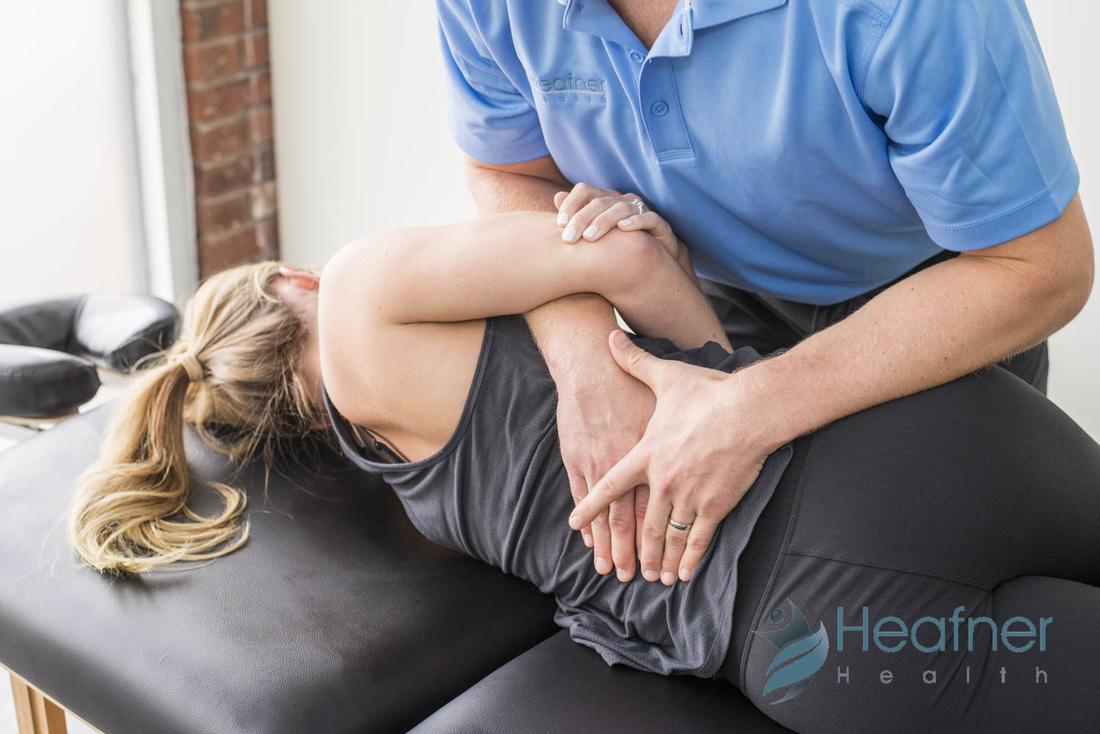|
Almost four out of five people will experience back pain at some point during their lives. Of this population, one in three will have a recurrent episode of low back pain. Acute back pain (new onset of pain) is terrifying. It can persist for several days to weeks before subsiding. A patient told me the other day, "it is the most excruciating pain I have ever experienced...and I have had broken bones, torn ligaments, and more." Fortunately, we now know that there are some simple steps to expediting the pain process.  Why does back pain occur? In perfect conditions - muscles, ligaments, and other structures operate at their optimal length and strength. To ensure this relationship, every muscle has an opposite muscle which helps stabilize proper movement. One of our most common postural imbalances effects the muscles of the hips and low back. This posture is commonly seen in those who sit at a desk for long periods of time. Generally, a shortened muscle becomes overused and strong. A lengthened muscle becomes weak and inefficient. To understand this relationship, compare the muscles of the body to that of a sail on a sailboat. A gust of wind will transfer all the weight of the sailboat toward one side of the boat. If the strength of the wind is too strong, the sails will snap and the boat will collapse. Now imagine the sail is your spine. If you place all your weight on your back, the muscles on the front must support your weight. Your lower back muscles are especially vulnerable to this prolonged posture. When your back fails to accommodate to the repetitive loading, pain is the result. What should you do after back pain occurs? Gentle movements, graded exercises, and a gradual return to activity is the best combination of self-care. To expedite this process, physical therapy can identify the cause of the pain and implement pain management strategies sooner. Additionally, retraining the core muscles is essential after an acute low back pain episode. See the video below regarding other tips and cues to expedite the pain process. *Pain should be investigated by a trained medical professional. The information contained in this blog post is intended to be a general approach to mechanical low back pain. It is best to discuss your pain with a medical provider prior to performing any exercise or training.
3 Comments
Don Heafner
5/26/2016 12:40:17 pm
Great low back video! I am now 68, super shape, only 8-10 percent body fat, run a fitness gym, work 4 days a week but my low back is killing me! I know I am sitting more and my past acrobatics is catching up....help! Even though I know what to do , it is still very painful😂🌴🏊🏿🚴
Reply
Manuel Franco
8/29/2023 10:49:12 pm
I just want to say Thank You to everyone who supported me through the years. My name is Manuel Franco, New Berlin, Wisconsin. My story of how I won the Powerball lottery of $768.4M is a bit of a tale. I have been playing Powerball tickets for 6 years now since I turned 18. I bought my first ticket on my 18 birthday. I was feeling very lucky that day because I had contacted Dr. Odunga Michael to help me with the winning Powerball numbers. I really had that great great feeling that I looked at the camera wanting to wink at it. I only did a tiny part of it and trusted him. He gave me the numbers after I played a couple other tickets along with it for $10. I checked my ticket after the winnings came online and saw the numbers were correct including the Power play. I screamed for about 10 minutes because it felt like a dream. I had won $768.4M. You can check my winning testimony with the lottery officials just with my name search. Thank you Dr Odunga. Well, his email is [email protected] and you can also call or Whats-app him at +2348167159012 so you guys can contact him
Reply
Hailey Garcia
6/20/2024 11:07:07 pm
My name is Hailey Garcia and I am from New Jersey. My herpes virus turned to war after 2 years of living with it. I have tried different medical procedures to cure my herpes but to no avail. Most people think herpes is only a minor skin irritation of which herpes has long term effects on health and passes through the bloodstream and can be easily contracted through sexual intercourse. I knew I had herpes from the first day I started feeling itchy in my pubic area and the pain was very unbearable. I couldn't stand it anymore. After 2 years of trying other means to get rid of it, I had to contact Doctor Odunga to help me with a permanent cure. I saw his email and whats-app number from a testimony I read online from a lady who was also helped by him in curing infertility problems, I had faith and contacted him. He assured me of his work and I ordered his herbal medicine. Within 5 days, I didn't feel any pain anymore and within 2 weeks, my skin was all cleared and smooth. I am very grateful to you sir and I write this testimony as others have done to bring those having faith to you sir. If you have herpes or other similar disease and you want it cured, kindly contact Doctor Odunga, Whats-App (wa.me/+2348167159012) OR Email [email protected]
Reply
Leave a Reply. |
Heafner HealthPhysical Therapy Archives
April 2024
Categories |


 RSS Feed
RSS Feed
